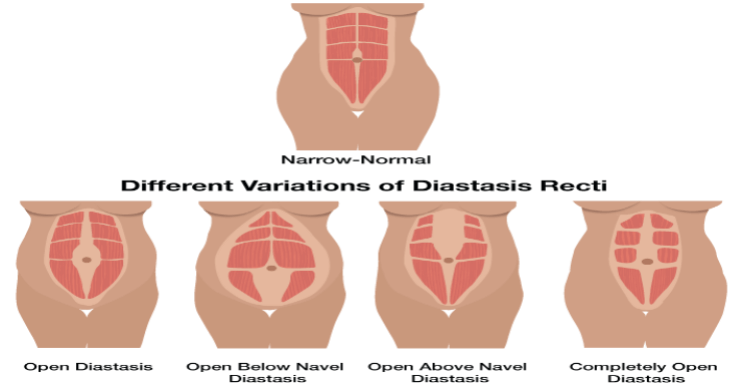‘The Secret Curse of the Mummy Tummy’
Gingerly lifting my ‘floaty’ top, I cried. I was 6 months post baby and I still looked pregnant. Why? How could this be? After my first baby, everything just sprang back into place (gestational diabetes did help the cause, but still, there should have been some improvements!).
Where my once toned, flat, smooth abdominals had once appeared, there was now this mushy, doughy skin – it was as if my stomach area had been put through the spin dryer and someone had forgotten to take them out.
Add a few silvery stretch marks into the mix, and you get the picture. I couldn’t bear to look at it, the thought of wearing a swimming costume on holiday let alone a bikini gave me shivers
There was no way I could wear skinny jeans, or any jeans for that matter, I decided skinny jeans were evil and only for those women who’d never had babies. I was still in my tummy hugger maternity ones, as they were the only things that could contain my stomach, and the only things there were comfortable.
I was horrified – here I was a fitness instructor with a belly looking this way! I’d look at other mums with babies the same age, and they all appeared to be getting their figures back to normal, so why wasn’t my pouch decreasing in size and returning to from whence it came?
That’s when I started to do some research, you see this was the days before I was a Pilates and holistic coach (and one of the reasons that I became one).
What is this tummy gap and how does it occur?
To give it it’s correct name – ‘Diastasis Recti’, and it occurs in about two thirds of pregnancies.
Diastasis– separation of body parts that are normally together
Recti – Rectangular, linear muscles (the 6 pack muscles of the abdomen)
The name itself is quite misleading as it implies that the muscles have separated, I get a lot of my ladies saying this. In reality it’s not the actual muscles that have parted ways, but the ligament they’re attached to has stretched (as it’s required to do during pregnancy), and not returned to its former place.
Pregnancy is one cause of Diastasis Recti, but men can get it too – any increase in abdominal size that creates an outward pressure on the abdominal wall can cause the ligaments to get stretched (you know when you see those guys with ‘beer bellies’ – same thing). Baby’s also can get it, because the abdomen muscles haven’t knitted together properly.
The ligament that runs down the length of the abdomen is called ‘Linear Alba’, this ligament is designed to stretch as the baby grows, after the baby is born it should start returning to normal, but often it doesn’t’.
As you can see there are varying types of diastasis and varying degrees of width.

There are other concerns as well to think about with a diastasis as it often goes hand in hand with certain conditions;
- Bad posture.
- Back Pain
- Pelvic Floor weakness (peeing when cough or sneeze).
- Constipation
- Bloating
How do I test for a gap?
To test for a tummy gap, you need to lie on your back on the floor with your knees bent. Now measure 3 fingers length down from your belly button.
Lift your head off the floor, this will activate the abdominal muscles.
You can feel if you have a gap by gently pressing with your fingers.
The gaps are measured in finger size.
How do I decrease my chances of getting a tummy gap?
- One of the best ways to reduce your chances of getting a tummy gap is to start building and improving your core strength BEFORE you get pregnant.
I have so many ladies contacting me when they’re already pregnant asking if they can start coming to classes, and it’s really NOT recommended to begin any new forms of exercise during pregnancy, even ‘safe’ ones like Pilates or Yoga (unless they’re a specialised Pregnancy class).
If you have been practising Pilates prior to pregnancy, then it’s fine to continue during but you need to make sure that your teacher is experienced and aware of your condition.
- The chances increase with each pregnancy, so although you may not have had it with your first child there’s no guarantee that you won’t get it with your second. So, start building your core strength as soon as it is safe to do so.
- The chances increase with age, over the age of 35 and you’re more likely to get a diastasis, so again start building your core strength prior to pregnancy (are you seeing a pattern develop here).
- Maintain a healthy diet and weight throughout pregnancy. This is so no further pressure is placed on already stretched ligaments.
- Drink plenty of water during and after pregnancy.
And now for the question that I get asked the most…. can it be fixed?
I actually hate the word ‘fixed’ as that Implies that it will be returned to its former glory and it will be done quickly. The answer is, it can definitely be ‘improved’, but it will take time and effort, there are no quick fixes here.
Even if you have followed all the advice above for decreasing your chances, there is still a chance that you might get it.
In extreme cases the gap may need surgery. As with any surgery this is really the last resort and should be considered very carefully before going down this route.
I see a lot of women with this condition and it can be a very emotional topic for them, it’s hard to accept that their body has changed significantly.
My Top Tips for anyone with a Tummy Gap
- Stay away from crunches, sit ups, planks or any other exercise that places too much strain on the tummy area. Instead do whole body exercises such as squats or lunges whilst focusing on keeping the tummy muscles drawn in, and controlled breathing.
- Do not lift heavy weights – I once had a lady who had gone to a kettlebell class and swung a weight which was too heavy for her and her innards came through her gap. She hadn’t ever been diagnosed with a diastasis, and she was 13 years post-partum!
- Try not to always carry your baby always on one side – as this will increase the ‘pull’ on that side.
- If you need to cough or sneeze – then hold your tummy so that you’re containing the pressure.
- Don’t do strenuous or prolonged exercise, as this will tire the muscles and you’ll have more chance of injury.
Exercises for Diastasis
What I say to all of my post-natal clients is that the exercises for increasing core strength are not your sexy, posing on Instagram type of exercises. These are concentrated, searching for tiny little muscles that you’ve never thought about before. Digging deep into your core and discovering places you never thought existed!
Lots of poking and prodding required to make sure that you’re switching on the correct muscles and equally important is switching off the wrong ones.
What I also would say (and I know that you’re going to say, ‘well she would say this’) is get yourself along to a properly qualified and experienced coach, who is well versed in helping ladies with this problem.
The value of this is immense.
I can’t tell you how many times I’ve had people come to me and say, ‘I watched a video’ or ‘did some exercises off YouTube’ – then when I actually test them and get my hands in and on them – they’ve strengthened all the wrong muscles.
So, although it will cost you more, if you’re serious about getting your core strength back, then you need to make that investment.
It’s not just about the exercise…
One of the main things that needs to be considered when healing a diastasis is nutrition. This is often overlooked by many trainers. Diet plays an important role, not just to help give the body the nutrients it needs to heal itself, but also so as not to place more pressure on an already weak area.
- Drink plenty of water – at least 2 litres per day, this will help move food through your system, thus helping prevent constipation. It will also aid tissue repair.
- Ensure you get plenty of fresh (preferably organic) fruit and vegetables.
- Eat plenty of good quality protein, particularly if you’re vegetarian or vegan.
- Eat lots of collagen boosting foods. THE best thing for this is bone broth – you can get my recipe here.
Breathing
Learning how to breathe properly is essential to healing a diastasis.
We take, on average, 25,000 breathes per day. If you’re breathing incorrectly, that’s 25,000 times per day that your healing potential has been lost.
Using your diaphragm when breathing is essential, as this will allow your tummy muscles to remain intact whilst you’re inhaling. Focusing on your breathe will also allow you to calm your mind and your body – essential for a new mum!
Next Steps
There are lots of things that you can do to help improve a tummy gap – improving core strength, correct nutrition for tissue repair, reducing the pressure on the tummy, improving your posture and learning how to breath properly are my top tips. These can be done before, during and after pregnancy.
I have helped lots of ladies improve their core function after giving birth. I have developed a specialist ‘Post Natal Package’ which you can get further information on all my packages here.
In the meantime, do let me know how you get on.
Jill
Corrective Exercise Coach (CHEK Practitioner I)
Holistic Lifestyle Coach II
Pilates Instructor Level 3
PS
This is now my tummy.
Good lighting and a good photographer, yes.
But no tummy gap.
I wanted to show this photo, not to show off, but to show you that it can be done.
It’s taken me 10 years to get it back.
10 years of correct exercise and diet – it’s not an easy fix, and it’s an ongoing process. But learning to love and respect your body on the way is hugely important.
It’s not about yo-yo dieting or ‘beasting’ your body with torturous exercise – it’s about working with your body and giving it everything it needsto help itself.

